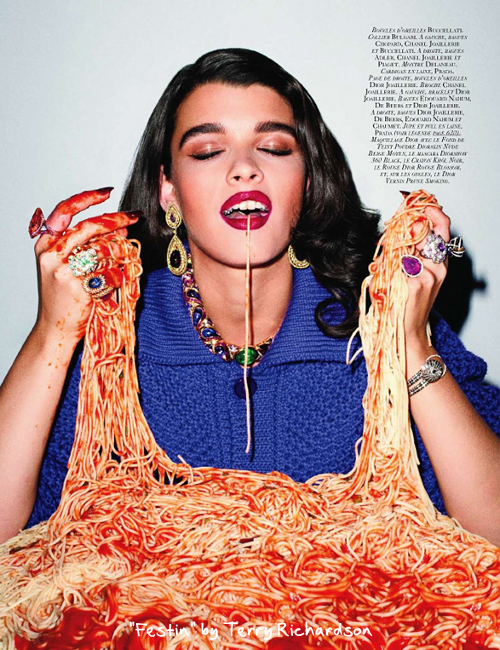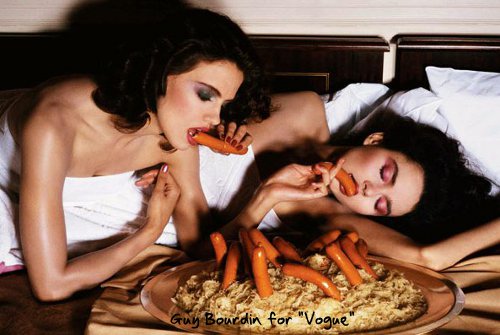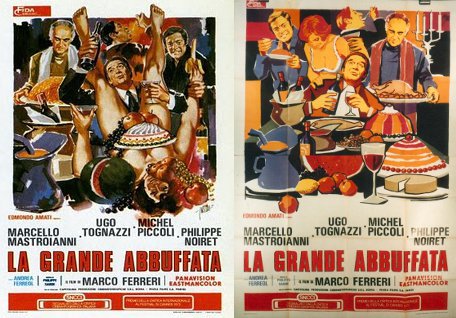While the fashion world is speculating on Carine Roitfeld’s unexpected departure from Vogue Paris, I think no one can deny the impact on her work on photography. I’ve always admired her cutting-edge, yet deeply Parisian, approach to topics which are often referred to as “taboos” (religion, sex, gender identity, food and weight, self-perception). One of the most interesting editorials by Carine, dealing with some of these subjects, was published in October 2010 on the Vogue Paris issue celebrating the 70th anniversary of the publication. Terry Richardson and Crystal Renn were the protagonists, respectively behind and in front of the camera.
Now, I know this editorial is a bomb, because the messages hidden under each picture are probably more thought-provoking than the pictures themselves; as usual, I’d like to leave controversies and my opinions aside [1] and to focus on what we are actually given in this shoot, so that everybody can judge for him/herself. Moreover, I will also comment on the styling and on the connections to the work of other photographers and to cinema.
In the photospread, the model is feasting on big quantities of food (in the pic above, for example, on spaghetti with tomato sauce). The quantity of food and her pose turn the picture into something extremely sensual or, on the contrary, nearly pornographic (in the sense that it explicitly shows an act – binge eating – which is often considered private). Food is the center of each picture, but what Crystal wore cannot be left out. Food has sometimes been paired to jewellery in fashion photography, but here we find an unexpected element: the model is wearing bulky, knitted sweaters, which remind me of what my sister and me used to wear in the late 80s. For this reason, the levels on which we can read the pictures are many: one refers to gluttony or sensuality (food), one to wealth (jewellery) and one to something familiar and cozy (knitted clothing).

Here, Crystal is eating underdone red meat and drinking a glass of red wine. The trademark realistic style of Richardson’s photography can be found in details, like the meat blood dripping on the model’s arm. In this case, another level (danger? death?) has been added through the cutlery on the plate, in particular the big knife. As for the jewellery, it’s not coincidental that she’s wearing pieces with purple stones (a reference to meat and wine).
Sensuality is never missing in these pictures, thus emphasizing the strong connections between food and sex (but I’ll write of this later). In the shot above, Crystal is sucking her fingers, presumably after tasting the food in front of her – a “mountain” of mashed potatoes and a boudin noir, a dark sausage made of pork and pig blood. As for the chromatic composition of the picture, the sweater and the sausage have the same colour.
This is probably the most explicit picture of the whole set: even if you’ve never watched Jamon Jamon by Bigas Luna, I guess everyone can see the sexual connotations of the shot. The model is eating a thick slice of raw ham and is holding a ham between her thighs, with a long knife stuck in it.
On the other hand, this is the creepiest, in my opinion: I hate raw fish, so watching Crystal putting a raw octopus in her mouth gives me the shivers [2]. One of her hands is holding the octopus, while the other is clutching a crab. The picture is based on contrasting colours, with an opposition between cold/livid shades (the octopus) and warm/earthy tones (the model’s sweater, the crab).
Crystal’s face and arm are again stained with red, but this time she’s eating Emmentaler and grapes. I really like this picture because it’s joyful and because the jewellery she’s wearing is to die for: look at the Van Cleef & Arpels grape-shaped necklace, isn’t it awesome? Everything beautifully contrasts with the cable-knit baby blue sweater. Another detail which has caught my attention is are Crystal’s long, edgy nails, adding an aggressive touch to her image.
The same sweater is worn in the picture above, where she’s eating roast chicken; here, she’s only wearing diamond and emerald jewellery. The juxtaposition of jewellery and food (not to mention the chicken) reminds me of an infamous picture by Helmut Newton, published on Vogue France in 1994. I don’t like the model’s expression: she’s sucking a chicken’s leg and her sunken cheeks make her look like a skull.
If you are Richardson’s fans or if you have a good visual memory, you may remember he shot an editorial with a very similar theme for Vogue Paris in 2004: Péché de cher, starring Natasha Poly, was published on the December 2004/January 2005 issue.
The differences are probably more striking than the similarities: Natasha is always wearing a black sweater and diamond jewellery and she’s eating street food (an ice-cream, a milk shake, a pastry, fried chicken, chocolate and a sandwich). The effect we get from this editorial is completely different: Natasha is a skinny model, she’s portrayed while approaching food with caution. I can’t see any hidden meaning, any metaphor in these pictures: I can only see a model pretending to eat.
Besides Newton, another possible source of inspiration for Festin could have been Guy Bourdin’s work.
The French photographer often included food in his glossy shots, and the picture above (two models lying in bed and feeding each other with wieners) is just an example. The final result is pretty cold, in my opinion: it fails in expressing sensuality and totally lacks the hot-tempered quality of Richardson’s pictures.
The closest example of an attitude to food similar to the one portrayed in Festin, can be found in a 1973 movie by Marco Ferreri, La grande bouffe (the original title is La grande abbuffata). I first watched this movie at a cinema club in the 90s, when I was studying cinema at university, and I remember it shocked me, because I’d never seen something like that before. The plan of four respected men (Marcello Mastroianni, Ugo Tognazzi, Michel Piccoli and Philippe Noiret played the leading roles) of retiring in the countryside to commit suicide through food and sex, sounded so anarchic to me.
Here are some playbills of the movie: both are centered on food, but the one on the left also introduces the theme of sex. Food and sex are two primary needs that are incredibly emphasized in La grande bouffe: the director used his unmistakably iconoclastic touch to reduce the hottest sex and the most delicious food into a black hole leading to death.
The most important female character was played by Andréa Férreol, a teacher who helped the protagonists to commit suicide. In the screencaps above, you can see some examples of the elaborate dishes made by the characters (see the cathedral-shaped cake and the breast-shaped Bavarian cream), in particular by Ugo Tognazzi, who played the role of a chef.
I think the same anarchy, intended as disregard for rules and social conventions, can be found in Festin. In the editorial, even if food is symbolical, it doesn’t have a nihilistic meaning: each picture wants to get a reaction from the viewer, to start a discussion on the importance of food and on our relation to food in contemporary society.
[1] Everybody knows Crystal is the most famous plus-size model. The concept of plus-size is a little bit ridiculous to our ears, but it makes sense in the world of fashion, where models are like walking human clotheshangers. In the past, when she started working as a model, she went through a painful experience of anorexia, which nearly caused her death. She reported her “story of appetite, ambition and the ultimate embrace of curves” in the self-penned book Hungry, published in 2009. The fact she has been chosen for this photoshoot has a double-sided meaning: her approach to food in the pictures can be considered un-complexed and joyful or, on the contrary, dangerous, overshadowing bulimia.
[2] The raw octopus reminds me of a beautiful 1997 commercial by Dolce & Gabbana, starring Monica Bellucci.










I love this post! I’m an huge Richardson fan and I agree with all you said about using food in fashion shootings. This one brings to surface the ambiguous and extremely important meaning food has obtained on last four decades focusing on its role as the new taboo since food, in my opinion, is the new explicit sex on fashion business. I believe showing naked bodies doesn’t shock anyone anymore but I heard many controversial reactions to this Terry’s work (thumbs up for him then…).
I also agree on La Grande Abbuffata reference, what a movie! The idea of an everyday, harmless-considered matter as food used as a weapon to kill. Great post again, you rule Teresa!
Food is the new sex in fashion editorials, you’re so right!
Very interesting post. You know, I love your photoshooting analysis.
This editorial has a strong impact on me. To tell the truth, I don’t like this kind of styling, in my opinion it’s too much overwhelmed. At the same time these images are attractive.
But that octopus in the throat is sickening. : )
I agree with you: these pictures are amazing because they’re exactly half way between attraction and repulsion.
Sicuramente le immagini sono di grande impatto, tipico della fotografia di Richardson (che non amo particolarmente).
Devo essere sincera: la visione di questo editoriale mi ha provocato un senso di fastidio e trovo che il termine pornografia sia quanto mai azzeccato.
Ma solo a me il gesto di Crystal nella terza foto (quella con la montagna di purè per intenderci) ha ricordato chiaramente quello per l’induzione del vomito tipico delle pratiche bulimiche?
Io non avevo dato questa interpretazione al gesto, ma effettivamente ricorda molto le “due dita in gola” per indurre il vomito. Per quanto possano mettere a disagio queste foto (e mettono a disagio, sono la prima ad ammetterlo), non si può negare che raggiungano così il loro scopo – riflettere sul rapporto/ossessione tra uomo e cibo.
I had no idea Carine Roitfeld was going to leave Vogue Paris and I must say it’s going to be hard to replace her.
I find these images extremely disquieting. In my opinion, they show a relationship to food that I would call “borderline” somewhere between a sickly attraction and an equally sick repulsion (which is perhaps what drives some to binge and throw up afterwards, but I’m no therapist so I’ll drop this here)
To be honest, I think that this feeling is already present in the photos, but by looking at the photos we too, as viewers, participate to this erotic/repulsive feast.
There are elements in the photos that are explicitely phallic (i.e. the rare meat in the second photo), some other instead are definitely sickening- if you rotated the octopus photo upside down, it would look as if Crystal was vomiting. The one that I find most disturbing, however, is the one with the cheese: she looks to me as if she was about to have a nervous breakdown. Powerful editorial indeed.
PS: I never saw la Grande Abbuffata, but your reference to films reminded me of Delta, a Hungarian film I saw where the protagonist, presumably anorexic, is forced to eat- I cannot describe how abusive and violent that felt.
Yes, she is going to leave next February. Today the news is that Emmanuelle Alt will take her place. Excellent choice, imo.
I totally agree on what you describe as sickly attraction and repulsion to food, and I also agree on the somehow helpless function of viewers, who cannot help but watching the feast.
I’m quite surprised by your opinion about the picture with the cheese and the grapes, but – again – here lies the power of this photoshoot: each picture is so full of symbols and hidden meanings, that it can be interpreted in many different ways.
No, I’ve never heard of the Hungarian film you are talking about, and I don’t think I’ll ever watch it.
Proprio ieri seram, in treno, ho letto su Vanity fair un’intervista a Crystal: credo di essere stata indubbiamente suggestionata da quelo che ho letto, ma in tutta sincerità queste immagini un po’ mi disturbano. L’ho trovato a tratti angosciante e non mi trasmette affatto l’idea di un rapporto sano e giocoso con il cibo, nè l’idea dell’innocente peccato di gola, ma piuttosto una voracità perversa e grottesca..
Direi che la tua definizione (voracità perversa e grottesca) descrive perfettamente una delle possibili interpretazioni del servizio.